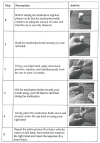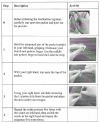Monitoring Opioid-Use-Disorder Treatment Adherence Using Smartwatch Gesture Recognition
- PMID: 40285134
- PMCID: PMC12031213
- DOI: 10.3390/s25082443
Monitoring Opioid-Use-Disorder Treatment Adherence Using Smartwatch Gesture Recognition
Abstract
The opioid epidemic in the United States has significantly impacted pregnant women with opioid use disorder (OUD), leading to increased health and social complications. This study explores the feasibility of using machine learning algorithms with consumer-grade smartwatches to identify medication-taking gestures. The research specifically focuses on treatments for OUD, investigating methadone and buprenorphine taking gestures. Participants (n = 16, all female university students) simulated medication-taking gestures in a controlled lab environment over two weeks, with data collected via Ticwatch E and E3 smartwatches running custom ASPIRE software. The study employed a RegNet-style 1D ResNet model to analyze gesture data, achieving high performance in three classification scenarios: distinguishing between medication types, separating medication gestures from daily activities, and detecting any medication-taking gesture. The model's overall F1 scores were 0.89, 0.88, and 0.96 for each scenario, respectively. These findings suggest that smartwatch-based gesture recognition could enhance real-time monitoring and adherence to medication regimens for OUD treatment. Limitations include the use of simulated gestures and a small, homogeneous participant pool, warranting further real-world validation. This approach has the potential to improve patient outcomes and management strategies.
Keywords: context-aware environments; ecological momentary assessment; human activity recognition; machine learning; medication detection; neural networks; smart healthcare; wearable sensors.
Conflict of interest statement
The authors declare no conflicts of interest.
Figures








Similar articles
-
Sea Horse Optimization-Deep Neural Network: A Medication Adherence Monitoring System Based on Hand Gesture Recognition.Sensors (Basel). 2024 Aug 12;24(16):5224. doi: 10.3390/s24165224. Sensors (Basel). 2024. PMID: 39204920 Free PMC article.
-
Detecting Medication-Taking Gestures Using Machine Learning and Accelerometer Data Collected via Smartwatch Technology: Instrument Validation Study.JMIR Hum Factors. 2023 May 4;10:e42714. doi: 10.2196/42714. JMIR Hum Factors. 2023. PMID: 37140971 Free PMC article.
-
Automated classification of hand gestures using a wristband and machine learning for possible application in pill intake monitoring.Comput Methods Programs Biomed. 2022 Jun;219:106753. doi: 10.1016/j.cmpb.2022.106753. Epub 2022 Mar 15. Comput Methods Programs Biomed. 2022. PMID: 35338885
-
Treating Women Who Are Pregnant and Parenting for Opioid Use Disorder and the Concurrent Care of Their Infants and Children: Literature Review to Support National Guidance.J Addict Med. 2017 May/Jun;11(3):178-190. doi: 10.1097/ADM.0000000000000308. J Addict Med. 2017. PMID: 28406856 Free PMC article. Review.
-
Medication-Assisted Treatment for Opioid-Use Disorder.Mayo Clin Proc. 2019 Oct;94(10):2072-2086. doi: 10.1016/j.mayocp.2019.03.029. Epub 2019 Sep 19. Mayo Clin Proc. 2019. PMID: 31543255 Review.
References
-
- Centers for Disease Control and Prevention Understanding the Opioid Overdose Epidemic. CDC 2024. [(accessed on 11 February 2025)]; Available online: https://www.cdc.gov/overdose-prevention/about/understanding-the-opioid-o....
-
- Maglogiannis I., Spyroglou G., Panagopoulos C., Mazonaki M., Tsanakas P. Mobile reminder system for furthering patient adherence utilizing commodity smartwatch and Android devices; Proceedings of the 2014 4th International Conference on Wireless Mobile Communication and Healthcare; Athens, Greece. 3–5 November 2015; Piscataway, NJ, USA: IEEE; 2015. pp. 124–127.
-
- Kalantarian H., Alshurafa N., Sarrafzadeh M. A Survey of Diet Monitoring Technology. IEEE Pervasive Comput. 2017;16:57–65. doi: 10.1109/MPRV.2017.1. - DOI
MeSH terms
Substances
Grants and funding
LinkOut - more resources
Full Text Sources
Medical
Miscellaneous

